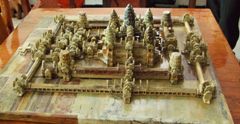Angkor Wat Temple
Angkor Wat Temple
Overview
Located in Northwestern Cambodia, Angkor was the Capital of the Ancient Khmer Empire. Today, it is a national symbol. The temples of Angkor are Cambodia's greatest tourist attraction, with over 1000 temples built between the9th and 13th centuries. They spread out over some 40 miles around the vicinity of Siem Reap, 192 miles from the Cambodian capital, Phnom Penh. They were built out of bricks and stones between the 8th and 13th centuries.
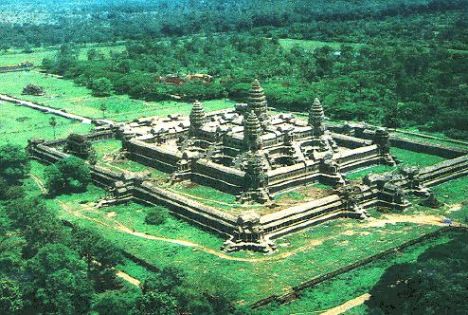
Angkor Wat is the most popular tourist attraction in Cambodia. It is a Cambodian icon that signifies the glory of Cambodia. It is regarded as the supreme masterpiece of Khmer architecture. It is a huge pyramid temple built by Suryavarman II between 1113 and 1150. It is surrounded by a moat 570 feet wide and about four miles long. The complex consists of five towers, which are presently shown on the Cambodian national flag. These towers are believed to represent the five peaks of Mount Meru, the Home of Gods and Center of the Hindu Universe.
How to Get There
Angkor Wat is located at the nearby town of Siem Reap. It can be reached via National Route 6, about 200 miles from Phnom Penh by buses and taxis available daily. It is about 5 hour journey on a good day trip across spectacle countryside view. Also, it can be reached by air and boat. Boat trip is not recommended at this time as there many safety concerns that have not been adequately address yet. If prefer to travel by air, the airport in Siem Reap has daily flight service from and to Phnom Penh. Regular flights abroad are also available from Thailand, Singapore, Vietnam, and Laos.

(This picture is published under the Creative Commons Attribution-Share Alike 2.5 Generic license.)
How to Visit
Siem Reap is a fast-growing town in Cambodia. It is a gateway to Angkor and is filled with lodging, dining, and tour-package options for all budgets and inclinations. For large group, tour buses may be the best choice. It can be prearranged. Taxi may be suitable for a small family whose itineraries are flexible and negotiable or on-demand. Tour bus and taxi are excellence choices for those interested in exploring more remote and off-the-beaten-track structures. For individual or couple, they may opt to hire motorcycle (tok-tok). Taxi and tok-tok can be arranged on demand from the hotel or any public market in town.
When To Visit
The best time to visit is December through February, when rainfall is less likely and the climate is most kind. Other time of the year, the weather is hot. It peaks in April before the May/June monsoon season. In the rainy season (September through November) you may be interrupted by heavy rain, treacherous roads, even though a lot new roads are built and the old ones are constantly repaired. However, you always find spots to visit. Most visitors want to experience sunrise at Angkor and Sunset nearby at Phnom Bakheng. Last week of September is said to be the best time as the sun is rising exactly at the central steeple of Angkor Wat as viewed from the main west entrance. You may be disappointed though on a rainy/cloudy morning as the sun is not coming out of the clouds. It usually rains a lot late September through November.
The Builder of Angkor Wat: Suryavarman II (1113-1150)
After a long fifty years of unrest, internal feuding and chaos, Suryavarman II defeated rival claimants to the throne and established sole rule over Cambodia. He was formally crowned in 1113, presiding by his guru, the powerful priest Divakarapandita. This was the third time the priest had officiated coronation in Khmer history. The king was a religious reformer who blended the mystical cults of Vishnu and Shiva, supreme Hindu deities, and promulgated Vaishnavism as the official religion, rather than Buddhism, which had briefly flourished under his predecessors.
After overcoming his rivals for the throne, Suryavarman began a series of successful invasions into neighboring
states and occupied what is now Thailand and Myanmar. Through his efforts, the empire re-established contact with China to the north and formed a powerful alliance with Champa to the east. In 1116 Suryavarman resumed diplomatic relations with the Chinese, the first since 9th century, according to Chinese historian Ma Duan-Lin. The Chinese officially recognized his kingdom as their vassal in 1128. By sending tribute to China, he acquired a powerful ally to discourage attacks from neighbouring Southeast Asian kingdoms and ensured that China would not interfere in Khmer domestic affairs. Historians believe during his decades in power, the king reunited the empire, reversing many of the benign policies of his predecessor.
Together with his Champa allies, Suryavarman launched an attack against the neighboring state of Dai Viet (Viet Nam) which ended in loss. The Champa King broke alliance with the Khmer empire. Upset with treachery, Suryavarman invaded neighboring Champa, deposed the Cham king in 1144 and annexed Champa in the following year. The Chams fought back and defeated Khmer troops in a decisive battle at Chakling, near Phan Rang, in southern Vietnam. Suryavarman put his brother-in-law, Harideva, on the Cham
throne, but Chams ' king Jaya Harivarman I deposed him and reclaimed the throne. In 1150 Suryavarman died in the midst of a new campaign against Champa, leaving his people exhausted by war and victimized by the once-subservient Chams, who eventually ravaged Angkor.
Suryavarman ÔÇÿs legacy was far beyond the territorial gains. He constructed a massive temple of Angkor Wat, the largest religious structure in the world. Angkor Wat is considered the epitome of Khmer architecture. To Suryavarman, it was an art work symbolizing the Khmer expansion. It also served as a masterful propaganda piece for the lord of the Khmer. Numerous bas-reliefs of the ruler cover the temple. Many of the sculptures depict Suryavarman among his court or in combat, but above all, they portray him as a calm and talented ruler. He was the first Khmer king depicted in art. Suryavarman's wondrous temple complex remains one of the a central symbols of Khmer heritage and today appears on the modern Cambodian flag.
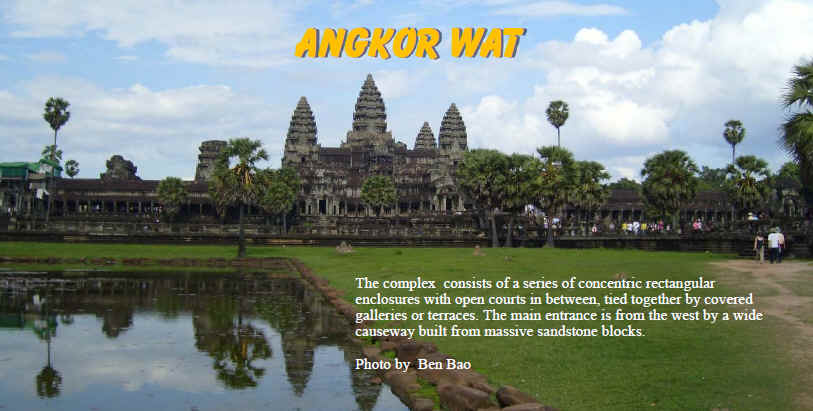
Angkor Wat is the largest Hindu temple complex in the world. The temple was built by King Suryavarman II in the early 12th century in Yasodharapura, the capital of the Khmer Empire. Khmer temples was usually dedicated to Shiva, but Angkor Wat was instead dedicated to Vishnu Vishnu, then Buddhist in 16th century. The temple is at the top of the high classical style of Khmer architecture. It has become a symbol of Cambodia. It is the country's prime attraction for visitors.
Architectural Styles

From the earliest time of the Angkorian monuments, Khmer architecture was continuously evolving, often from the rule one king to next. It was based on a central theme of temple-mountain. In addition to its religious and political influence, Hindu mythology also dictated the architectural layout and artistic content of most pre-Bayon (i.e. pre-Buddhist) monuments. Temple-mountains' such as Bakong, Ta Keo, East Mebon, Pre Rup, Baphuon and Angkor Wat were based on the layout of mythological Mt. Meru, which sits at the center of the universe, and is the home of the gods of Hindu mythology. Mt. Meru is a five peaked mountain surrounded by six other mountain chains and oceans.
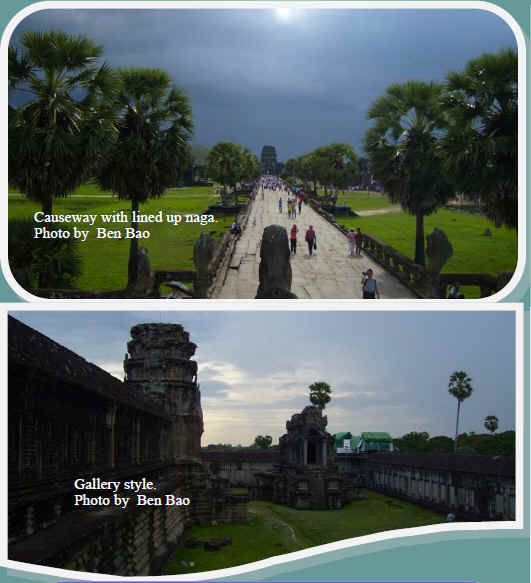
This plan is reflected in the architectural layout of temple-mountains in which moats surround a multi-tiered temple pyramid, peaked by towers representing the peaks of Mt. Meru. Hindu mythology finds a more literal expression in the temple carvings. A variety of scenes from Hindu mythology can be found although the most commonly carved mythological characters are apsaras - celestial dancers generated in the froth as the gods churned the oceans to create the elixir of life. There are nearly 2000 apsara images carved in Angkor Wat alone.
To adhere to this fundamental idea, many earliest temples were usually constructed on real hill or in a representation of a hill. Peah Vihear is one of them. The tower of the temple represents a mountain on a tiered base. The summit was usually a sanctuary with one door facing east and three false doors at the remaining of the cardinal points of the compass. By the time of Bakheng period, the layout was being evolved. The summit was crowned with five peaks, four at the point of compass and one in the center. The architecture of Angkor Wat features this layout on a grandiose scale and came with entry tower and causeway lined up with nagas(mythical serpent) leading up to the temple.
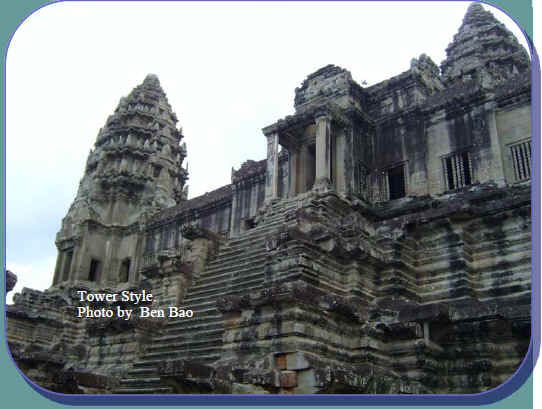
Its architecture is a combination of temple mountain and galleried temple. It was designed to represent Mount Meru, home of the devas in Hindu mythology, within a moat and an outer wall 3.6 kilometers long. At the center of the temple stands a quincunx of towers. Unlike most Angkorian temples, Angkor Wat is oriented to the west. The reason is unknown. Scholars are divided as to the significance of this. Some believe it was constructed as a royal tomb. Nevertheless, the temple is admired for the grandeur and harmony of the architecture, its extensive bas-reliefs, and for the numerous devatas adorning its walls.
The central tower in Khmer architecture later became less prominent, although it remained a focus point. The central tower later was flanked by courtyard and richly decorated galleries. Smaller towers were placed on gates and on the corner of the walls. They represent a religious and astrological significance. The architecture refinement culminated in Angkor Wat period which showcases the evolution of Angkorian style.
Bas-relief

Angko Wat 's complex consists of rectangular enclosures or galleries. The walls of enclosure features the longest continuous bas-relief in the world, which runs along the outer gallery walls, narrating stories from Hindu Mythology. The mass of bas-relief carving is of the highest quality and are the most brilliant Khmer arts. The carving always tells a story of some sorts.
On north wing of the west second-tier enclosure or walls from the west main entrance, the bas-relief depicts the battle of Lanka and the south wing, the battle of Kurukshetra. The south enclosure, the bas-relief of the west wing depict the historic procession and the south wing, the heaven and hell,. The corner where the south and east enclosures meet depict the churning of the sea of milk. The corner where the north and east enclosures meet and along the east wing of the north enclosure depict the victory of Vishnu over Asuras. The west wing of the north enclosure depicts the battle of Devas and Asuras.
Crossing the cruciform terrace and ascending staircases passing through three successive galleries lead to the Third Gallery renowned for its exceptional and bas-reliefs, beautifully carved to the walls continuously, 700m long, 2 meter high, the longest reliefs in the world. There literally thousands of figures drawn from the Hindu epics and the courts of Suryavarman II.
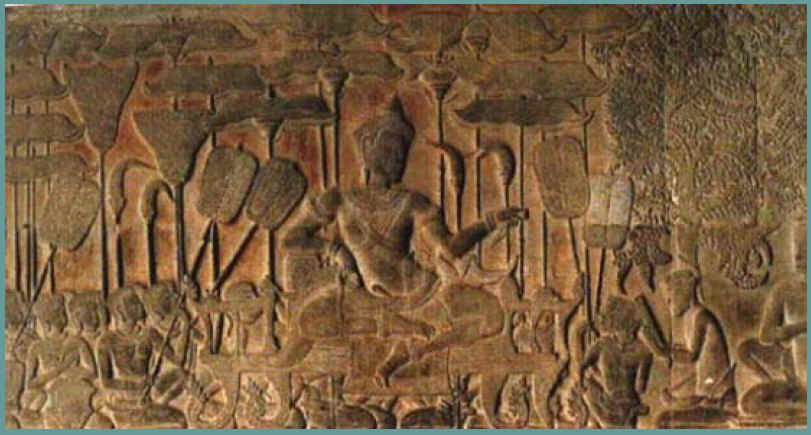
Suryavarman II is depicted at the west wing of south gallery of bas-relief in Angkor Wat. He is shown enthroned in majesty talking with Brahmans of the courts, one of whom holds a manuscript in his hands, perhaps a list of army dignitaries marching past the king. The king seated on throne covered with rugs, surrounded by courtiers carrying umbrellas, fans and fly whisks.
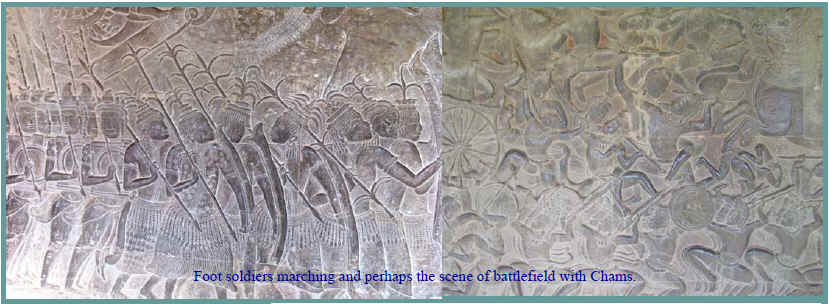
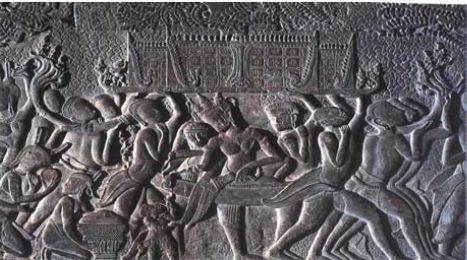
This bas-relief depicts a procession of the King and Queen, in palanquins and chariots, and the concubines to the Royal Court. Zhou Daguan wrote that palanquins are made from one piece of wood, curved in the middle, with two ends rise vertically and carved with flowery motifs plated with gold or silver.
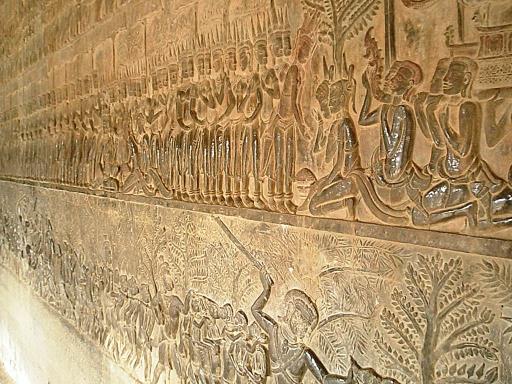
A section of "Heaven and Hell" from the east side of the south wall, a "Heaven" scene, a princess parts with the queen, a royal processions, a "Hell" scene, and unpleasant, harsh punishment.
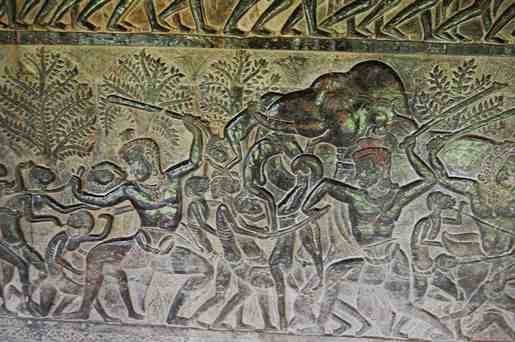
Apsara
Apsaras are supernatural beings in Hindu and Buddhist mythology, appearing as young women of great beauty and elegance. They are proficient in the art of dancing. They are the wives of the Gandharvas, court servants of Indra. They dance to the music made by their husbands, usually in the palaces of the gods, and entertain gods and fallen heroes. As Hinduism and Buddhism made ways into Cambodia, Apsara became a symbol of dancing art. The walls of many Angkorian temples are covered inside and out with bas-reliefs and carvings including Apsara. Nearly 2,000 distinctively rendered apsara carvings adorn the walls of Angkor Wat. Other fine apsara carving arts are also found at the walls and pillars of Bayon temple.
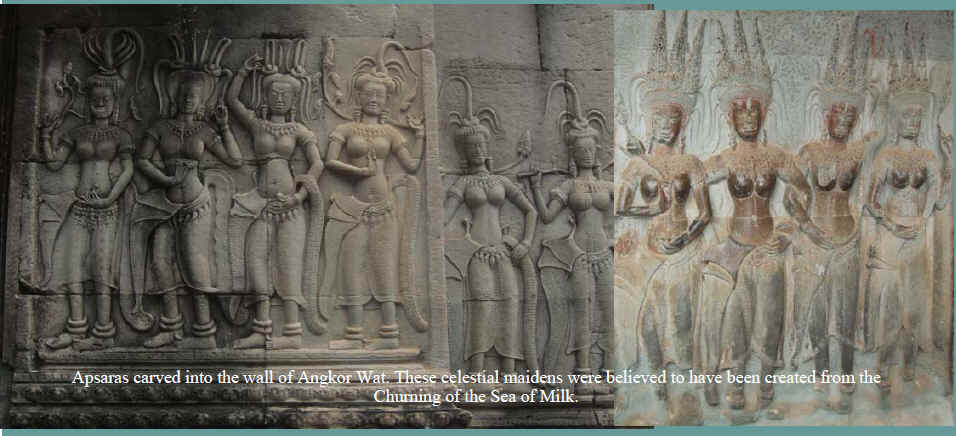
Suggested Reading
- 14 July 2006. The Greater Angkor Project has uncovered overwhelming evidence that Angkor was the biggest single pre-industrial complex on the planet. There are many parallels between the modern megalopolis and Angkor, the medieval Cambodian city which is the focus of a four-day conference at The University of Sydney conference from 18 July.
Read more... - The lost tribe of Cambodia: Mysterious 'body jars' buried on cliffs in death rituals by 'previously unknown ancient people'. Body jars buried on ledges 160ft up.
Read more




